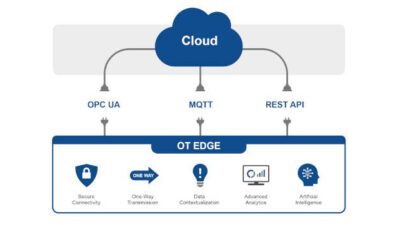Manufacturers looking to find answers quickly to complex problems within factories, buildings, and process control applications are using augmented reality.
A self-contained holographic computing device is designed to provide a 3-D augmented reality (AR) view of process data, which can be used in conjunction with integrated human-machine interface/supervisory control and data acquisition (HMI/SCADA) software. To understand advantages of such new tools, it’s sometimes interesting to take a step back and take a close look at the evolution of technology in manufacturing and process control automation.
The concept of a programmable logic controller (PLC) debuted almost 50 years ago, the effects of which can be found ingrained in much of today’s automation solutions. A short time later, PC-based software emerged, although early iterations were mainly text-based.
Microsoft’s Windows operating system and use of a graphical user interface (GUI) provided a way for automation software to monitor and control equipment via 2-D graphic symbols that, over the years, grew in ability and complexity. Within an even shorter time frame, comparatively, processors evolved from 32- to 64-bit, and introduced a paradigm shift in the world of process control. Mission critical data could be collected at breakneck speed, and the former 2-D images used in HMI/SCADA software could now be rendered quickly in 3-D, providing an almost lifelike representation of connected objects and environments.
These technological advances have served as fundamental building blocks for future innovation. The PLC gave necessity to PC-based control, which led to GUIs making life easier for operators, which led to advances in graphics processing. The next step is using holographic computing devices with "digital twins."
Additional location-based features
Compatibility with holographic computing devices is one of the numerous AR and data mobility features available in manufacturing or process control applications. Additional location-based features in modern HMI/SCADA software include:
- NFC (Near field communication). This allows users to create a connection to any supported device without the need for a physical connection, enabling users to monitor or configure data and settings remotely with automatic connection and without need for additional infrastructure.
- GPS (Global Positioning System). GPS leverages latitude and longitude information to display data associated with that location and associated equipment. Mobile users can view information preconfigured for a user’s physical location.
- OCR (Optical character recognition). OCR allows mobile devices to derive information from scanned standard alphanumeric characters.
- Barcodes. This type of scanning helps prevent operator confusion by utilizing physical tags associated with equipment.
- QR Codes (Quick response code). This allows users to scan pre-established physical QR codes on a device and retrieve current and historical information about that device in real time.
AR application benefits
A typical Industrie 4.0 AR scenario can involve training, simulation, maintenance, remote assistance, or a number of other use cases. For example, a technician using an integrated device with HMI software can look at the ceiling and see the relevant information about the heating, ventilation, and air conditioning (HVAC) system, how the equipment is laid out, and learn about specifications such as pressure and flow. Installations and aggregates obscured behind linings and false ceilings also can be visualized, together with their current status messages. In this way, errors can be detected and corrected more quickly.
If ventilation is not working properly, perhaps it turns out that the error is not in the fan, but in the power supply. This instance can be seen quickly in the AR environment. The operator can then call up corresponding circuit diagrams and signal states. Documentation such as maintenance instructions also can be opened in a context-sensitive manner.
The goal of these AR scenarios is to quickly find solutions within factories, buildings, and complex, multi-asset environments. Workers equipped with solutions such as an integrated HMI can get in touch with service representatives immediately through the connected device and either provide or receive instructions for repair, along with corresponding interactive holograms.
Beyond AR
Developers and users are pushing the boundaries of what’s possible with hardware and software in AR. Just as technology for manufacturing and process control evolved from the earliest days of the PLC, through DOS, through 2-D GUIs and 64-bit computing, it’s inevitable that eventually there will be new ideas that expand upon today’s AR capabilities.
Melissa Topp is the senior director of global marketing at Iconics Inc. Edited by Chris Vavra, production editor, Control Engineering, CFE Media, [email protected].
MORE ADVICE
Key Concepts
- Augmented reality (AR) is designed for manufacturing and process control applications and gives the user a holographic 3-D perspective.
- Industrie 4.0 can provide additional insights for AR applications.
- Using AR is designed to help users find quick solutions in applications that are becoming more complex.
Consider this
What other applications could benefit from using augmented reality?



